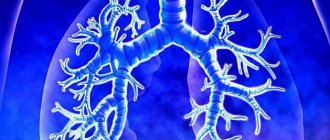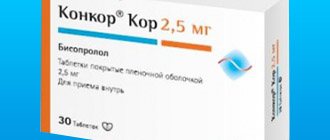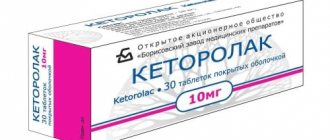Single
Tablets 10 mg
Blood and lymphatic system disorders: increased tendency to bleeding.
Immune system disorders: hypersensitivity reactions, including anaphylaxis; eosinophilic liver infiltrates.
Mental disorders: sleep disorders, including nightmares, hallucinations, insomnia; irritability, anxiety, agitation, including aggressive behavior, tremors, depression, suicidal thoughts and suicidal behavior (suicidality).
Nervous system disorders: headache, dizziness, drowsiness, paresthesia/hypoesthesia, seizures.
Cardiac disorders: palpitations.
Gastrointestinal disorders: abdominal pain, diarrhea, dry mouth, dyspepsia, nausea, vomiting.
Disorders of the hepatobiliary system: increased activity of transaminases in the blood serum (alanine aminotransferase, aspartate aminotransferase), cholestatic hepatitis.
Disorders of the skin and subcutaneous tissues: angioedema, the appearance of ecchymosis, urticaria, itching, rash, erythema nodosum.
Musculoskeletal and connective tissue disorders: arthralgia, myalgia, including muscle spasms.
General disorders and disorders at the injection site: thirst, asthenia/fatigue, discomfort, swelling.
Cases of the development of Churg-Strauss syndrome (systemic eosinophilic vasculitis) have been reported in patients suffering from bronchial asthma while taking montelukast.
Chewable tablets 4 mg and 5 mg
Below are adverse reactions by systemic organ class according to the MedDRA classification, which are common (>1/100,
For 5 mg chewable tablets:
From the nervous system: headache.
For 4 mg chewable tablets:
From the gastrointestinal tract: pain in the abdomen.
Common disorders: thirst.
During post-marketing research, the following adverse events were identified:
From the blood and lymphatic system: increased tendency to bleeding.
From the immune system: hypersensitivity reactions, including anaphylaxis; eosinophilic liver infiltrates.
Psychiatric: sleep disturbances, including nightmares, hallucinations, psychomotor hyperactivity (including irritability, anxiety, agitation, including aggressive behavior, and tremors), depression and insomnia, suicidal thoughts and suicidal behavior.
From the nervous system: drowsiness, dizziness, paresthesia/hyperesthesia, seizures.
From the cardiovascular system: rapid heartbeat.
From the gastrointestinal tract: diarrhea, dry mouth, dyspepsia, nausea and vomiting.
From the hepatobiliary system: increased activity of liver transaminases in the blood serum (AST, ALT), cholestatic hepatitis, pancreatitis.
From the skin and subcutaneous tissue: angioedema, the appearance of ecchymosis, urticaria, itching, rash, erythema nodosum, tendency to bruise.
From the musculoskeletal system: arthralgia, myalgia, including muscle cramps.
General disorders: asthenia/fatigue, discomfort, swelling.
In very rare cases, while taking montelukast, patients with bronchial asthma develop Churg-Strauss syndrome.
There is no specific information on the treatment of overdose. There are no data on overdose symptoms when taking the drug in adult patients with bronchial asthma at a dose exceeding 200 mg/day for 22 weeks and at a dose of 900 mg/day for 1 week.
Cases of acute overdose of montelukast have been observed in adults and children at doses above 1000 mg (approximately 61 mg/kg for a child aged 42 months). The most commonly reported adverse events were consistent with the safety profile of montelukast and included abdominal pain, somnolence, mydriasis, thirst, headache, vomiting and psychomotor hyperactivity.
There is no data on the possibility of removal of montelukast during peritoneal dialysis or hemodialysis.
In the rhythm of breathing
In general, bronchial asthma is a kind of allergy to certain components of the human environment. This disease has accompanied people since ancient times. The fate of a person suffering from such an illness was unenviable. Only at the beginning of the 20th century did people begin to develop knowledge in the field of allergology, and then the connection between allergic manifestations and asthma was revealed.
Modern medicine uses two types of drugs to treat bronchial asthma. The first includes basic therapy medications that affect the mechanism of the disease and make it possible to control its course and minimize the risk of attacks. The second group of drugs are symptomatic drugs, the main purpose of which is to relieve an attack. The need for medications of the second group can be considered an indicator of the quality of therapeutic therapy: the better the basic drug is chosen, the less often there is a need to use symptomatic drugs.
Specialists prescribe "Singlon" for allergies (bronchial asthma - a kind of allergy) as an alternative or additional medication in cases where the patient suffers from mild or moderate asthma. The doctor can also replace low doses of corticosteroids with this drug for patients with mild bronchial asthma.
Pharmacokinetic characteristics of the drug
The instructions attached to the drug "Singlon" state that the absorption process of the product is quite rapid. The average bioavailability after use (regardless of food intake) is 64%. The main active component of Singlon is more than 99% bound to plasma proteins. 24 hours after taking the medication, its concentration in all tissues of the body is minimal. The drug is intensively metabolized. The influence of metabolites on the therapeutic effect of the drug is minimal. 86% of the taken dose of the drug is excreted from the body through the intestines, the share of participation in the process of excretion by the kidneys is less than 0.2%. The maximum dose of Singlon itself and its metabolites is excreted in the bile.
Interactions with other medicinal drugs and other types of interactions
Single®
Can be prescribed simultaneously with other drugs that may be used for the prevention or treatment of bronchial asthma. While monitoring drug interactions, the clinical dose of montelukast does not have an important clinical impact on the pharmacokinetics of the following drugs: theophylline, prednisone, prednisolone, oral contraceptives (ethinylest). diol/norethindrone 35/1), terfenadine, digoxin and warfarin.
In patients who took phenobarbital simultaneously, the area under the concentration-hour curve (AUC) for montelukast decreased by approximately 40%. Montelukast fragments are metabolized by inducers of CYP3A4, 2C8 and 2C9, it is necessary to exercise caution, especially in children, if montelukast is administered simultaneously with inducers of CYP3A4, 2C8 and 2C9, such as phenytoin, nobarbital and rifampicin.
In vitro follow-up
demonstrated that montelukast is a potent CYP2C8 inhibitor.
Data from a clinical follow-up study of drug interactions involving montelukast and rosiglitazone (a marker substrate; a drug metabolized by CYP2C8) showed that montelukast is not a CYP2C inhibitor 8 in vivo.
Therefore, montelukast does not have a significant effect on the metabolism of drugs that are metabolized by an additional enzyme (for example, paclitaxel, rosiglitazone and repaglinide).
In vitro follow-up
It was established that montelukast is a CYP2C8 substrate and a minor 2C9 and ZA4 substrate. During clinical follow-up, drug-drug interactions with montelukast and hemfibrozil (CYP2C8 and 2C9 inhibitor) doses were increased by hemfibrozil, which increased systemic infusion of montelukast in 4.4 times. In case of one-hour treatment with gemfibrozil or other strong CYP 2C8 inhibitors, dose adjustment of montelukast is not required, but the drug is responsible for reducing the risk of adverse reactions.
Results are monitored in vitro
There is no evidence of clinically important interactions with less potent CYP2C8 inhibitors (for example, trimethoprim). Coadministration of montelukast with itraconazole, a strong CYP3A4 inhibitor, did not significantly increase systemic infusion of montelukast.
Pregnancy and lactation
No studies have been conducted on the use of montelukast in pregnant women. In global marketing experience, there have been cases where babies whose mothers took montelukast during pregnancy - the main component of the drug "Singlon" (instructions, reviews do not recommend doing this) - occasionally experienced congenital limb defects. However, it later became clear that these women were also taking other drugs to treat bronchial asthma. Therefore, it is not possible to speak with certainty about the cause-and-effect relationship between the manifestation of such defects and the use of montelukast. But before prescribing AC to a pregnant woman for treatment, the doctor must carefully assess all possible risks to the health of the mother and child.
There is no information about whether montelukast is excreted in breast milk. Therefore, it is also important to assess the benefit-risk ratio here.
Exceeding the maximum possible dose, consequences
In most cases of overdose of the drug "Singlon" known to medical specialists, no particularly severe side effects were observed. In a small group of patients, an excessive dose of montelukast, the main active ingredient, caused a reaction in the form of abdominal pain, headaches, thirst, nausea, and a state of hyperactivity. There is no information about whether the drug is eliminated by hemodialysis. There are no specific data on the treatment of overdose with montelukast. There is also no antidote.
If for some reason the maximum permissible dose was exceeded and any side effects appeared, the patient should be prescribed symptomatic treatment.
Indications for use
The main sphere of influence of “Singlon” is bronchial asthma. Moreover, experts recommend taking the drug both during the treatment course and in the remission stage. In addition, the medication can be prescribed to those people who suffer from hypersensitivity or even intolerance to acetylsalicylic acid (“aspirin” asthma). The drug is effective for the prevention of bronchospasms due to physical effort.
As an additional therapy, "Singlon" instructions allow it to be used in cases where persistent asthma (severity - mild to moderate) is ineffectively controlled by first aid means such as inhaled corticosteroids and short-acting beta-agonists.
The essence of the “work” of the drug is that it is able to block bronchospasms by reducing the activity of bronchial peristalsis, resulting in a reduced likelihood of developing an attack. Despite the fact that Singlon is absorbed (its analogues behave differently in this regard) quite quickly, it is considered a long-acting medication. Simply put, it works and performs its “duties” in the human body for many hours.
Contraindications to the drug
A contraindication for taking the medication is the patient's hypersensitivity or individual intolerance to montelukast, the main component of the drug "Singlon". The composition of the auxiliary components can also cause serious health problems in sensitive patients. Instructions for use strictly prohibit people suffering from severe forms of liver disease and phenylketonuria (a metabolic disorder of amino acids, mainly phenylalanine) from taking the drug.
"Singlon" (4 mg) instructions prohibit use by children under two years of age. The use of the medicine in a dosage of 5 mg is unacceptable for children under 6 years of age. Well, and, accordingly, the instructions do not allow children under 15 years of age to prescribe the highest dosage of the drug “Singlon” (10 mg).



